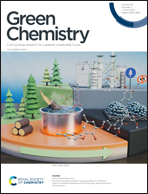Coupling of solvent-free synthesis and reactive extrusion of alumina: an ecologically efficient integration for heterogenous catalyst synthesis†
Abstract
Innovation in materials manufacturing processes is a challenge to reduce the environmental impact of the chemical industry in line with sustainable development objectives, such as promoting sustainable industrialization and ensuring responsible consumption and production patterns. One of the ways to reach this goal is to revisit the main synthesis processes and to rethink their use. Reactive extrusion is a well-known continuous process used to produce and shape various materials in the polymer and food industries, but hardly leads to the direct synthesis and shaping of metal oxide materials (ceramics). In contrast, sol–gel chemistry offers tremendous opportunities to synthesize metal oxide networks by polycondensation of molecular precursors at a low temperature, but it is mostly operated in sluggish batch processes, using massive amounts of solvent contaminants and producing large amounts of chemical waste (E-factor > 40). In this work, for the first time, we coupled extrusion with sol–gel chemistry to produce high surface area shaped alumina-based materials that meet or exceed the requirements to be used as heterogeneous catalysts or catalyst supports. The necessity to adapt sol–gel chemistry – usually done in a diluted environment – to meet the twin-extruder technical constraints – usually working in a viscous environment – led to a peculiar choice of reaction conditions little discussed in the literature: the hydrolysis/condensation of (solid) alkoxide precursors without a solvent. We were able to synthesize and shaped high specific surface area boehmite (γ-AlOOH) at room temperature, in a continuous mode, and under solvent-free conditions. The solids are directly shaped in the form of self-standing “spaghetti” or extrudates. Upon calcination, the shaped hydroxides are converted into mesoporous and high specific surface area gamma alumina (γ-Al2O3) materials. We show that such materials exhibit high catalytic activity in the dehydration of ethanol. The process intensification presented here paves the way towards very low-waste, low-energy, and – all in all – more sustainable manufacturing practices for shaped high surface area metal oxides. In addition, it could be potentially less expensive since the simplification of the equipment and the lower energy consumption will contribute to drastically reduce the production costs even if the reagents are more expensive.



 Please wait while we load your content...
Please wait while we load your content...